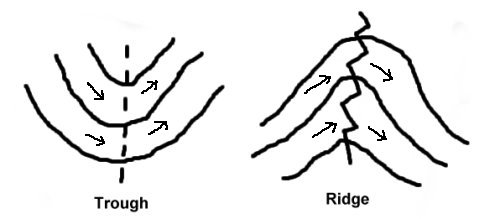
The primary characteristic of a trough is that it is a region with relatively lower heights. Height is a primary function of the average temperature of the air below that height surface. For example, if it is 500 mb heights then the 500 mb height is based on the average temperature between the surface and 500 millibars. The density of air changes with temperature. As the temperature of air cools in becomes more dense and thus more compacted (takes up less volume). Thus, as air cools the height lowers since the air is becoming more dense. Air will cool when it rises, thus a trough can be found where there is a lifting of air. A trough can also be found in a region dominated by a very cold air mass. This troughing will be most pronounced in the upper levels. A trough can bring in cloudy conditions and precipitation or they can bring in a cold air mass. A ridge is a region with relatively higher heights. A broad region of sinking air or a deep warm air mass will both lead to ridging. Since air is often sinking within a ridge they tend to bring warmer and drier weather. Troughs and ridges are analyzed on pressure surfaces aloft such as 850, 700, 500 and 300 mb. Troughs tend to bring in cooler and cloudier weather as they approach while ridges tend to bring in warmer and drier weather as they approach. Look for troughs and ridges at the 300 mb level at link below (toggle to 850 mb once at site to find areas of cooler and warmer temperatures): http://weather.unisys.com/nam/300.php  |